Well, it’s been a while. My reasons for my impromptu hiatus are my own, and will stay that way, but I’m glad to be back. Thankfully, Anne has been providing some great content to prevent too much of a virtual tumbleweed infestation in these here parts.
The first thing to start clearing from my virtual in-tray is an account of my trip to Oman, and a discussion of what my research out there is all about. I’m going to start with the former. What you’ll discover is that on a typical fieldtrip as much time is spent travelling and logistical wrangling as is spent at the rock face. Fortunately, it does give me the chance to show off some photos.
Day 1. The first step in any field trip is getting yourself and all your equipment out into the wild. In this instance, the start of the adventure was notably unglamorous: I was forced to get up ridiculously early to catch a long-haul flight. There’s no way to make a long-haul flight it cattle class sound exciting, because it isn’t. The best I can say is that it was uneventful, and we were fortunate not to run into problems with the Omani customs officials, despite the presence of things like hammers and drilling equipment – not the sort of thing to calm the suspicious – in our luggage. However, by the time that our journey from my flat to a Muscat hotel was finally complete, the day was pretty much over.
Day 2. The first order of business today was to meet with our collaborators at Sultan Qaboos University (one of the many, many, buildings which has been named after the current ruler of Oman). It’s a sprawling, modern-looking campus, and it was nice to see a significant proportion of the students wandering around campus were female, a noticeable contrast with the situation beyond the gates of the University, where the visible population was highly skewed towards the testosterone end of the spectrum.
In the months prior to coming out, we had been in contact with the head of the Geology department, who had offered to aid us in our sampling work. As it turned out, the assistance on offer far exceeded my expectations: on almost every day of our visit, someone made themselves available to accompany us, and direct us right to the best places to drill. The fact that we didn’t have to spend much time driving in circles trying to locate good outcrops must have, at the very least, doubled the amount we managed to get done during our trip; and that’s before you consider the assistance with accommodation, and places to eat, and sorting out car hire….
After thrashing out a rough schedule for our time in Oman, and arranging to depart for our first field area on the morrow, we had time for a little bit of tourism. We spent the evening visiting the oldest part of Muscat, checking out the harbour and an old (but still very touristy) indoor market.


For better or worse, some vendors really went overboard in honestly embracing the tackiness.
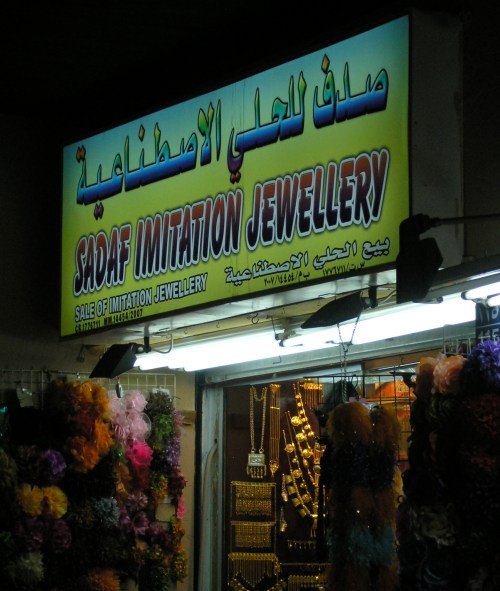
We had dinner at a ‘pick your own fish and we’ll grill it for you’ outlet.
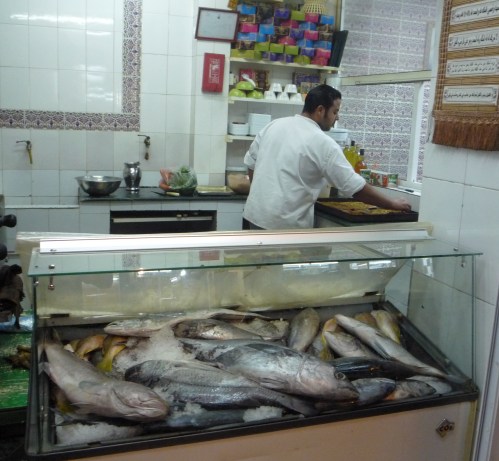
It might look a little downmarket but it was delicious. Omani grilled fish, served with rice, was one of the staple meals during the trip, and I can honestly say that I was perfectly happy with that state of affairs – it was uniformly delicious. Eating with my fingers took rather more getting used to.
Day 3. The hire vehicle of choice for the first part of our trip was a Toyota Land Cruiser. Nothing wrong with this, beyond being of almost tank-like proportions, wit the steering wheel on the wrong side, and needing to be driven in a country where everyone drives on the wrong side of the road. Theoretically anyway, because Omani drivers are fairly nuts – although two years in South Africa has given me some valuable experience in coping with people with a somewhat idiosyncratic approach to speed limits, the highway code and the preservation of their own existence. Fortunately, one benefit of being nominally in charge of the whole excursion was that I could delegate driving duties to someone else.
The journey to our first sampling targets in central Oman started off spectacularly, as we drove through the range of mountains which squash Muscat against the coast. As well as being scenically impressive, these mountains are actually the eroded remanents of an ophiolite – a bit of oceanic crust that was thrust onto the Arabian shield about 80 million years ago. After passing through the mountains, things flattened out considerably, and after several hours of somewhat monotonous driving, we reached a guest house that was quite literally in the middle of nowhere.
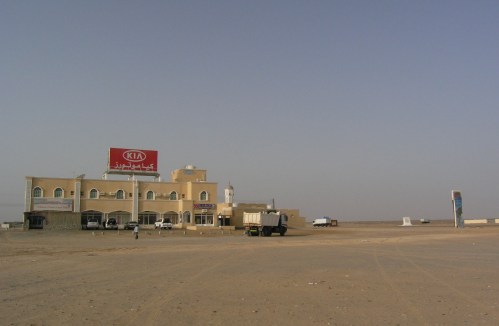
Day 4. Finally, the chance to get some sampling done, although it proved rather more challenging than we’d hoped. We were hoping to sample these thinly laminated 600 million year-old red sandstones and siltstones.

This proved to be rather easier said than done – not only were the rocks themselves rather delicate, quite easily breaking apart along the bedding planes, but our drill was also playing up and vibrating rather fiercely. The end result of this was at best thin and gnarly cores, and at worst thin and gnarly cores fractured into dozens of pieces. It was rather hard on the wrists too.
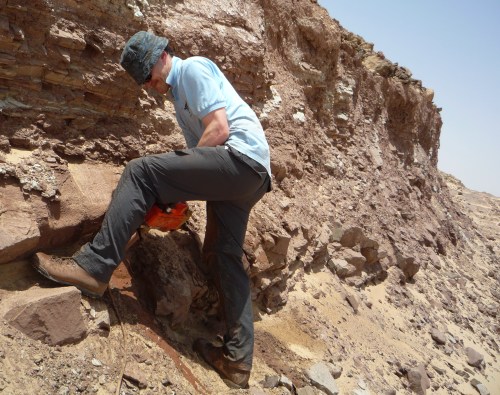
Although we managed to collect a few rather ropey cores, in many places we had to execute a back-up plan: we hammered out oriented block samples that we can hopefully extract more healthy cores from under controlled conditions.
So a rather vexing day, and tiring too: the temperature must have been approaching 40 C, and it being a Muslim country wearing shorts was not encouraged. Neither was an evening beer.
Day 5. Today’s target rocks were both older -around 800 million years old – and a bit further off the beaten track than yesterday’s. In fact, without the regional knowledge, not to mention the desert driving skills, of our Omani colleagues, I doubt we would have found anything at all, because this is what we saw when we arrived at the alleged outcrop:
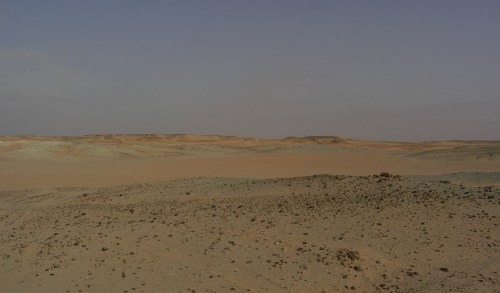
Beautiful, certainly, but not obviously a locality of great geological interest. Lots of sand, and most of the visible rock was weathered to pieces. However, after a bit of poking around we found a half-dozen places where the exposure was fresh and solid enough to drill – and because these were hard volcanic ash flows, drilling proved to be much less fraught than yesterday (although my wrists were still feeling the vibration.
After a successful morning collecting lots of nice core, stage one of our mad dash around Oman was complete. It was time to make the long drive back to Muscat.



Comments (4)